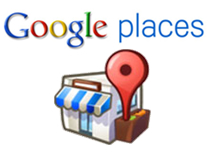TIP #1
I’m talking about your Google Places listing.

Consider
this example: When you search for “hotels, Boston”, the Boston Harbor
Hotel ranks #1 in the Google Places search results. To the right of the
result, you can see all the information that the Boston Harbor Hotel has
placed in its Google Places listing. They’ve included reviews, hotel
information, and pictures of the hotel and its surrounding area.
Here’s how to set it up for yourself: Visit https://www.google.com/places/.
To set up your business on Google Places, click the ‘Get Started Now’ button below the text, “Get your business found on Google.” Your Google Places account will be connected to your Google account. Here, you can enter the country and business phone number. Google will then search to see if your listing already exists. (Keep in mind that you can edit a current listing at any time to display new information about your business.)
If Google Places doesn’t identify any business information online for you, you can manually add it. After filling out your phone number, Google will prompt you to input more information. As you complete your information, Google will automatically generate what the Places advertisement will look like on the right, including the map image. Make sure you’re satisfied with the appearance of your listing. Keep the description short and to the point, capturing the main concept of your business and product or service. You can add anything you want, including a coupon link for your business to attract more customers to your website.
You can then set up whether or not your business provides services in a certain area or areas. This will allow your business to appear on map listings. When people search for a business similar to your listing,
your business will appear on a map within a specified range. You can then select which location(s) your services cover(s). The map will show you what area will be covered by choosing this option. If you choose
option #1 (“Distance from one location”), the map will show a general area that will be covered by your services. You can then choose what location will be the central point.
If you prefer to serve only certain cities or areas within a city, you can choose the second option and pick the areas you serve. This option can be helpful for companies that are only able to serve a certain area, such as a pizza delivery company, or in a very niche market, like a jet ski company on a beach.
Another aspect of an effective Google Places advertisement is the hours your business operates. Often, when people are searching for your business, they’re looking to see when you’re open, and Google allows you
to include this directly in your listing. If you sell products or services directly to your customers, either online or in-store, you also have the option to let customers know ahead of time what forms of payment you accept.
Almost done – Now, you can include other information that may be vitally important to potential customers at your place of business or at your online retail site at the end of the listing set-up process. This information can range from details about the location if it’s difficult to find, to information about the products and services your business provides. Use this as an opportunity to tell potential customers why your business is worth a second look.
Finally, the first time you create a Google Places listing, you will need to validate your location. This helps Google avoid fake listings and advertisements. Google will send you a postcard with verification information and next steps on it. Although it may seem like a pain to wait 2-3 weeks before your listing can get verified and become live, it saves us all in the long run from a plethora of spam listings when we use Google Search to find places in the future.
TIP #2
Google has a program called Google Grants that many nonprofits might not know about.

What
is it? It’s $10,000 in-kind grant monkey given every month to members
of Google for Nonprofits for free advertising on Google. Considering
there are over 3 million searches performed on Google every day, there’s
certainly a great opportunity to capture donor traffic – Google says
that implementing Google Grants has the potential of 10,000 to 40,000
new website visitors a month.
If you’re interested in taking advantage of Google Grants, here are a few things to keep in mind:
• Create a campaign that aligns with your goals. You should have
robust keyword lists, leverage brand terms, and include problem- and
solution-oriented keywords.
• Use all three match types when creating your keyword list – broad, phrase, and exact match.
• Drop visitors on the most relevant, targeted page on your website in relation to the ad. It helps with conversion rates.
• Keep forms on those pages as short as possible to increase conversion rates.
TIP #3
Google’s pretty good at surfacing relevant content based on your search query.
But
sometimes you need something so insanely specific that a general
keyword phrase doesn’t really do it for you, especially for marketers on
the hunt for a specific piece of content. Enter the Google site:-
search. This allows you to search just one domain — not the entire
internet — for a particular search term.
So, for instance, if you wanted to see what kind of content HubSpot,
and only HubSpot, had on marketing automation, doing a site:search
would limit the results to only HubSpot’s marketing automation content.
It’s a critical shortcut for marketers who create a lot of content, need
help finding data points on specific sites, of want to perform
competitive analyses. Here’s how to do it:
Step 1: Go to Google.com.
Step 2: Enter site:www.website.com search term into the search box.*
*Pay attention to the subdomain (the letters that precede a domain name, like www., blog., or info.) you enter. Which subdomain you enter, or even choosing not to enter one at all, will change your results.
Step 3: Refine your search. For instance, in Step 2
when I searched our blog for a Facebook stat, some results from a long
time ago — like 2010 — came up. I could filter for only the most recent
stats by refining my search to site:webdog.me facebook stat 2012. And
there you have it: a quick and dirty search tip that’ll save you tons of
time and frustration when you know what you’re looking for – just don’t
know where it’s hiding.
TIP #4
Indexing as many pages on your website as possible is tempting for marketers

who
are trying to boost their search engine authority. While it’s true that
publishing more pages that are relevant for a particular keyword
(assuming they’re also high quality) will improve your ranking for that
keyword, sometimes there’s just more value in keeping certain pages on
your website out of a search engine’s index.
Why would you want to keep pages out of search engines?
One of the most obvious use cases is thank you pages – where visitors
land after filling out a form on your landing page. If your thank you
pages are indexed in search, it’s possible for people to find or give
away your gated content for free.
So, there are two ways to ask Google not to index your pages in search:
Option #1: Via a Robots.txt File
The first way to remove a page from search engine results is
by adding a robots.txt file to your site. The advantage of using this
method is that you can get more control over what you are allowing bots
to index. This means you can proactively keep unwanted content out of
the search results.
Within a robots.txt file, you can specify whether you’d like to block
bots from a single page, a whole directory, or even just a single image
or file. There’s also an option to prevent your site from being crawled
but still enabling AdSense ads to work. That being said, of the two
options available to you, this one requires the most technical kung fu.
To learn about how to create a robots.txt file, refer to this article
from Google Webmaster Tools.
But if you don’t need all the control of a robots.txt file and just
want to get straight to the point, use my favorite — the second option.
Indexing as many pages on your website as possible is tempting for
marketers 09 Free Advertising on Google, and Other Little Google Tips
Marketers Should Know And here is the meta tag within the header: And
this signifies the end of the header: Boom! That’s it. This tag tells a
search engine to turn around and go away.
Option #2: Via a “noindex” Meta Tag
Using a meta tag to prevent a page from appearing in search engine
results is both effective and easy. It requires only a tiny bit of
technical know-how, and it’s actually just a copy/paste job if you’re
using the right content management system. ..
TIP #5
The internet moves pretty fast, and it’s hard to keep up if you’re worried about monitoring your company’s online reputation.

Luckily, Google has a free tool that makes it easier: Google Alerts. Here’s how to use it.
1. Visit Google Alerts and Complete the Form.
At https://www.google.com/alerts there is a simple form you can fill
out to get alerts emailed to you about new results for different search
terms. Start by putting in your company name, selecting
“Comprehensive”, “as-it-happens” and your email.
2. Confirm Your Email. Google will send an email to the address you
used for the alert. Click on the link in the email to confirm you want
the alert.
3. Repeat for More Alerts. You can repeat this process to set up
additional alerts. See below for some ideas for different alerts to set
up.
4. Create a Google Account to Manage Your Alerts. This step is
optional, but recommended. By creating a Google Account you can see all
of your alerts on one screen, and can add more alerts, edit your alerts
or delete them easily. Now that you know how to set it up, here are
some tips to use Google Alerts like an expert.
1. Track Your Company. Have a Google Alert running for your
company’s name so you know when new content is published about our
company.
2. Track Your Products. This is a good way to stay informed about
how many bloggers are writing about your products. If you have products
with different names than your company, set up alerts for them, too. The
internet moves pretty fast, and it’s hard to keep up if you’re worried
about monitoring your company’s online reputation.
3. Track Your Executives. Set up alerts for important people within
the organization so you can keep tabs on blogs and news articles that
mention them.
4. Use Phrase Search. If your company, products, or executives have
more than one word names, you should use phrase search in the alert —
just put quotes around the search term and Google will only match on the
phrase.
5. Use Negative Keywords. Google Alerts will actually track new results for any search terms, including advanced terms. For instance, if your name is Bob Loblaw and you want to keep your email from getting cluttered with results that are about Arrested Development, use the search “bob loblaw -arresteddevelopment”.
Bonus: Simple Ways to Boost Website Traffic
Research shows that just 20% of a website’s content
consistently brings in traffic. That means that 80% of your existing
content is essentially waste!
An 80% wastage rate is very high, especially if it can be avoided. So
how do we get wastage down? Even to just 60% would by definition double
your existing traffic.
- There are three key steps to getting your content to generate more traffic:
Improve your site’s Strength and Authority – Your site needs to be
structured so that it can be successfully “spidered” (Wiki) by search
engines. It also needs to be an authority so that it attracts other
quality and relevant sites linking to yours. To be an authority, you
need to publish new content regularly, to attract more links from other
quality sites and… more traffic. - Develop a Sound Content Strategy – You absolutely must know your
audience, topic areas and design metrics, in order to measure your
content. - Publish High-Quality Original Content – Good content grows your
following and makes you an authority. This is extremely important.
Remember… “Content Is King”
There is no quick solution to increasing your web traffic overnight. You need to get the foundations to your SEO (Search Engine Optimisation) right – good URL structure, sound (keyword)
tagging strategy, solid site architecture. And then you need to
research more to support your content efforts and provide you with fresh
and original material.
If you’re not sure about what sort of content will work for you, aside from Google Analytics, there are specialists like Parse.ly that take existing data and repackage it in much more user-friendly ways.











